Only lazy dreams of his own pool. If you have a house outside the city with a small adjacent territory, but you are absolutely indifferent to growing vegetables and colors, install a pool for a full-fledged rest. And so that water procedures give even more fun and use, you should take care of the heating of water. For this there are many different techniques, and today we will talk about how to warm the water in the pool with your own hands.
Water heating devices
The heating of the pool is one of the most costly and time-consuming events, and if the prefabricated or inflatable structures can quickly warm up from the roast summer sun, then everything is not so simple with stationary. Before embarking on the construction of a basin heating system, sanitary standards and generally accepted standards of a comfortable water temperature should be studied. So, the normal swimming temperature is considered + 24C or higher, but all people are different, and this parameter may vary depending on age, health status and personal preferences.
As an example, it is possible to consider standards for children's pools, where the water temperature should be not lower than + 28c. Be that as it may, heat the water to such a mark without special devices will not work. There are several options for heating units, some of which are quite really done with their own hands.
Heat exchanger for the pool
Heat exchangers for heating water in the pool are one of the most common options. The device is a large flask equipped with a coolant. It is connected to the heating system or to a stationary water heating device. The coolant inside the flask circulates along the contours and redistributes thermal energy, as a result of which the water continuously enters the pool, warming up to a comfortable temperature.
For the most efficient operation of the system, heat exchangers are often equipped with thermal sensors with an automatic control unit. It is necessary so that the device is turned on only in those moments when water becomes colder than the desired temperature. This saves energy, maintain a stable temperature and extend the deadlines for the operation of the device.
Simply put, the water entering the pool becomes warm due to the water heated in the heating system of the house. It is unlikely to construct such a device with your own hands without technical and engineering skills, so in this article we will look at the options simpler.
Electric heaters for the pool
Electric heaters are more suitable for compact home pools. The entire electrical heating system is in a separate compartment taking cold water from the water supply system. This system is based on ordinary laundry (one or more). Their power should be selected so that they can maintain the water temperature at the desired level. For calculations, the temperature is usually taken for 400 to ensure the necessary performance stock. When cold water passes through the Tan system, it heats up and goes into the pool.
The disadvantage of this method of heating the basin is very large volumes of electricity consumption, since the Teni have high power. For this reason, the electrical heater is not always obtained in the houses of the old building with low-power wiring.
Important: Before making an electric heater, find out the power of wiring in your home. If it is insufficient, contact the Energonadzor with a request to highlight additional power. Unfortunately, in most cases, the energy reports simply cannot accomplish this, since the old wiring cannot endure a larger load. Output from this situation can be the installation of its own substation. This is quite expensive, but guarantees complete independence and ease of use of electricity.
For heating large volumes of water, and in the case of the pool, we are talking about tons of fluid, a lot of electricity is required, the tariffs are growing from year to year. And at least make a penny electric heater is the easiest way to pay for accounts will be given impressive sums.
Boilers and stoves for the pool
Quite unusual, but still a real way of heating water in the pool. It is more suitable for compact stationary structures or for summer baths for 1-2 people. Boilers or furnaces can work on gas, diesel fuel or firewood. The last option is the most economical and easy to implement.
To install the gas boiler, it is required to obtain permission in the appropriate instance. But if there are no permissions, but you are not going to call professional installers, you can make a simple and efficient wood stove with a serpentine.
It will save not only financial, but also time costs for water heating. Firewood is the cheapest and easily accessible type of fuel, and in order to warm the water in a small pool, they will need no more than on the preparation of kebabs.
Make such a warm summer pool with your own hands is very simple, and just below we will tell you how the installation of the wood stove occurs.
Heat pumps for the pool
The principle of operation of the heat pump is very simple: it takes heat from surrounding sources, converts it and transmits water or air (depending on what you need to heat). For heating the open pool, the mechanisms that are selected by air are used mainly and transmit it water. If summer was very hot, the effectiveness of such a heater will be at height.
The appearance of the heat pump very much resembles an ordinary air conditioner. Most modern models of these devices are fully automated. This means that it only needs to be included and set the desired temperature - everything else will make it yourself. The control is carried out on the panel located on the housing, or using the remote control, which is also very convenient.
Natural sources of energy
Very interesting and up-to-date topic that is actively developing the last few years all over the world. A person has long understood that the exhaustable energy sources will end sooner or later, and they cost considerable money, so they create various ways to use inexhaustible resources. These include solar and underground heat, wind energy, etc.
All of the above pool heating systems are quite practical, but have one common drawback - the cost of operation. The pool itself is not cheap, and regular heating of water in it will constantly "tilt" the family budget. The energy extracted from the external environment is not a penny, however, to convert it in a desired way, it will be necessary to present the means and strength to the heat of the heater.
The first option is a geothermal heat pump that will take heat from the deep layers of the Earth and underground reservoirs. To do this, you will need to drill a well (if it is not yet on the plot), omit the special probe to the bottom, by which the coolant will circulate. The pump will raise the coolant from the bottom up, take the heat energy and transfer it to the heat exchanger.
The second version of the natural heater is the most common - solar collector. This technology allows without serious financial and labor costs to quickly heat the water in the pool to the desired temperature. At the same time, it is possible to use it both for pools in the fresh air and for indoor structures. The collector consists of a system of glass tubes, combined into a single heat exchange path. The tubes are heated with hot sunny rays, transmit heat into the heat exchanger, and it is in water.
Solar collector do it yourself
The use of solar energy is the optimal solution for water heating in the pool with both financial and from a practical point of view. To explain the device and the specifics of the installation of the solar collector, consider its construction on the example of the indoor pool with a volume of 10 m³. The calculation of the heating of the pool should be carried out depending on the amount of water that needs to be processed.
Principle of operation
The pool is an electric pump, taking cold water and transmitting it to a metal-plastic coil. The coolant passes through the pipes, gradually heating under the sunny rays, after which it hits the pool through a special hose, only from the opposite side of the intake hose.
In the diagram you can see the place where the collector connects to the pool. Air over a special valve leaves. The collector's tees are connected as short corrugated hoses leading to the pump. Short them must be done in order to reduce heat losses.
Tools and materials
To make the solar collector with your own hands, you will need to thoroughly work and stock materials, but all efforts will pay off the first month of summer.
To assemble the heater for the pool, materials will be required:
- bar with square cross section 50 mm - 38 m;
- plywood with a thickness of 12-15 mm - 5 m²;
- metal plastic pipe with a diameter of 0.5 inches - 110 m;
- plastic fasteners for pipes - 160 pcs;
- coal adapter for metal-plastic pipes like "Dad-Mom" - 60 pcs;
- coal adapter for metal-plastic pipes like "Mom-Mom" - 62 pcs;
- adapter for fitting with a diameter of 0.5 inches - 105 pcs;
- exhaust air valve - 1 pc;
- check valve - 1 pc;
- tee with a diameter of 0.5 inches - 3 pcs;
- drain valve with a diameter of 0.5 inches - 2 pcs;
- submersible pump 3-4 m³ / h - 1 pc;
- corrugated hose - 2 pcs;
- sheet metal - 5 m²;
- aluminum profile height 12 cm - 4 pcs;
- steel corner (galvanized) 50x100 mm - 4 pcs;
- glass 4 mm thick - 4 pcs;
- nitrocracy of black - 5 l;
- board 30x100 mm - 9 m;
- ruberoid (or other rolled waterproofing) - 5 m²;
- paving slabs with a thickness of 40 mm - 4 m²;
- self-tapping screw;
- plumbing Fuma tape;
- river sidewged sand;
- silicone sealant.
Materials are very much, but it is not worth saving on them - all costs will pay off. Wood can choose the most ordinary, for example, pine. Before use, it is recommended to be treated with antiseptic preparations so that the design does not start rot, or insect pests did not start. Ordinary rolled waterproofing is also inexpensive. But fasteners and adapters are better to immediately buy the highest quality.
Assembling solar collector
First of all, you need to choose the right place where the solar collector will stand. It is clear that it should be an open outdoor space on the south side of the site. The distance from the collector to the pool must be minimal.
Progress:
- Follow the platform for a collector at 5 square meters. M and remove the fertile soil layer (usually its thickness is from 20 to 35 cm).
- Align the bottom, sink and pour 10 cm layer of sand.
- Square sand with water and thoroughly confuse. It will perform the function of the drainage system so that the base of the collector is not wet from underground or sedimentary waters.
- On the sand the rolled waterproofing. Place the cuts of the brass at each other by 10 cm, on the walls of the pit - by 15-20 cm.
- Put the pavement tile.
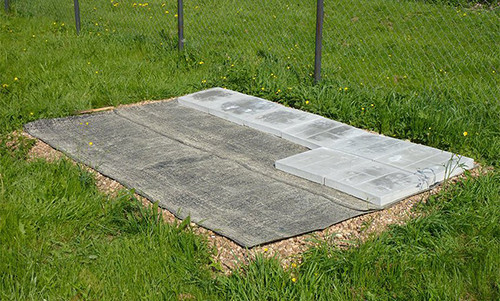
- Make a frame of square bars, connecting the parts from the corners.
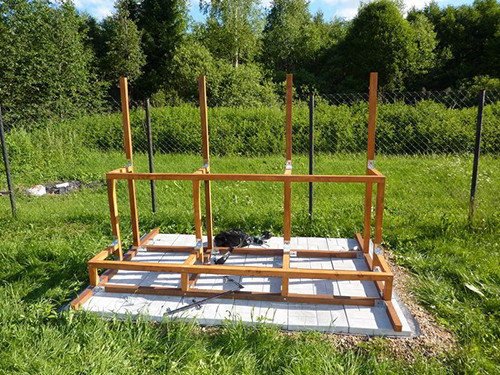
- Collect the plane (table) for the collector and attach it to the frame at the desired angle, placing in the southern direction.
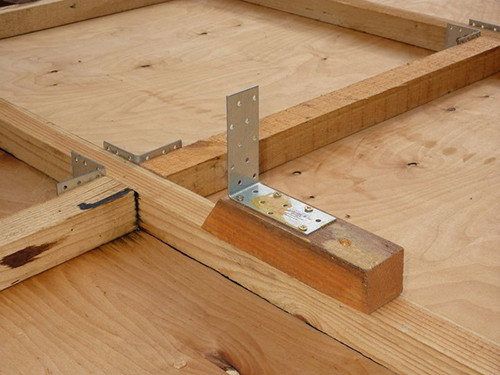
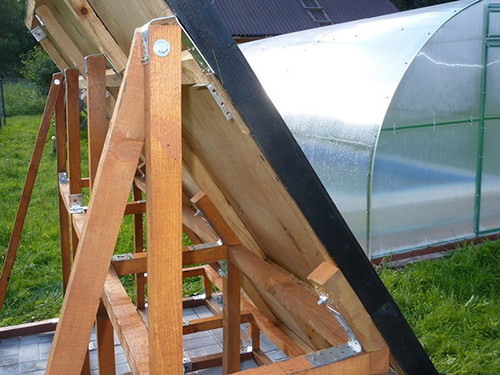
- Aluminum pegs to fit the construction to the ground.
- Make marking on the collector plane at the points of the tubes.
- Color all angular adapters ("Pap-Mom" and "Mama-Mom") black nitrocrase. It is most convenient to use aerosol paint.
- In the designated places on the table, screw the adapters.
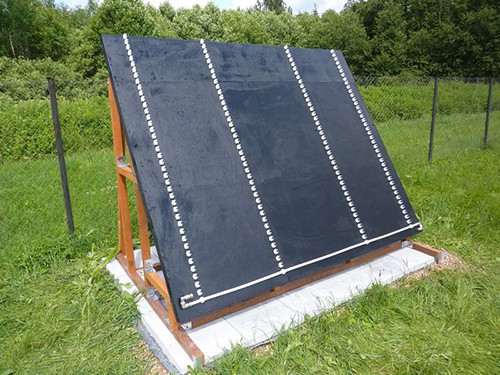
- Collect the framework of the shield and cover it with plywood.
- Raise the shield and lock it on the frame.
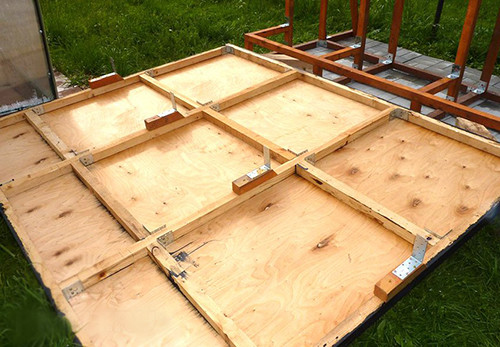
- Taking advantage of the corners, all over the perimeter of the design, make fires from the boards, cutting the groove to insert the glass.
- At the paneur, attach sheet metal and paint the entire shield in black.
- Recover the location of the mounts for metal-plastic pipes with a chalk or pencil with a pitch of 45-50 mm.
- Install the fasteners and insert the metal-plastic pipes in them with the corresponding length. Use Fuma Tape to enhance fasteners.
- Collect a serpent, using fittings and corners.
- Drill two holes in wooden sideboards to remove pipes, and at their ends, set the tee.
- Collect the remaining drainage scheme (hoses, valves) and carry out hydraulic testing. If everything went successfully, paint the entire coast of Nitrocha.
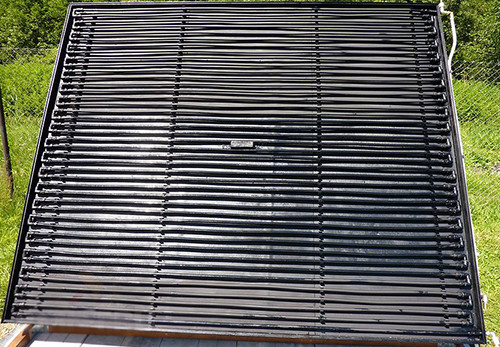
- In the central part of the shield, lock the support bar and collect a frame from aluminum profiles.
- Cut the glass of the corresponding sizes, mark them around the perimeter with silicone sealant and put into the grooves located on wooden sidewalls and aluminum profiles.
- In the center, where 4 glasses are joined, a potentially vulnerable and weak place, so it must be strengthened. To do this, install the lining, and with the sides, screw the segments of the corners.
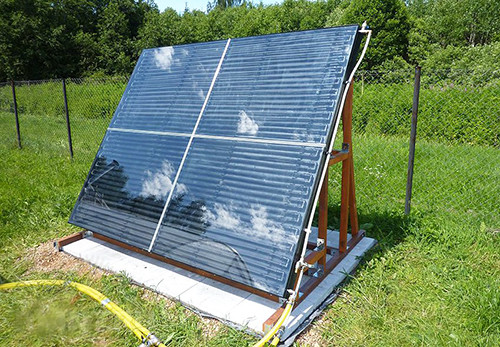
- Move the power and install a waterproof outlet inside the pump.
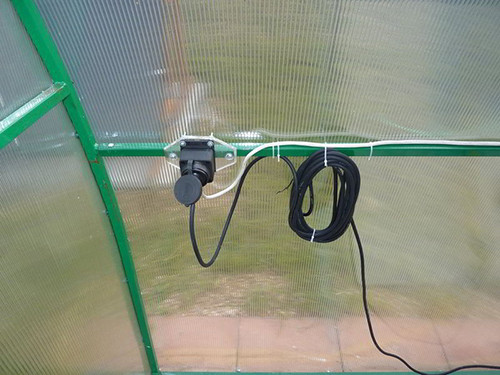
- Run the pump and tested.
This assembly is quite simple, and the system is not automated, and therefore it will be turned on and off manually.
Useful advice: When the collector heats the water in the pool, turn off the power for security reasons, then go swimming. Otherwise, you risk getting a burn from hot water that will enter the pool along the bottom.
As a bonus, in addition to free water heating, you get a small flow that is formed during the reservoir. It does not allow water in the pool to stir.
In this video about the heating of the pool of solar energy, an alternative method of creating a heater is shown:
Wood burning stove
In this chapter, we will tell you how to warm the water in the pool with a conventional wood-burning furnace. Of course, it is not enough for a large amount of water, but for a summer bath or a small reservoir, where children and relax adults can be splashing, it will completely come down. The most pleasant is that it is not much difficult to collect such a heater, and the money for heating goes at a minimum.
The principle of operation of the unit is as follows: inside the furnace is a metal coil, when the fire is bred in the furnace, water is pumped into the serpent with the help of a pump, passes through it, heats up from hot metal and comes out on the other hand, where in another pump enters the pool.
The most important thing in this business is to be able to calculate the water flow rate in such a way that it does not boil in the coil, but only heated to the desired temperature. To do this, you need to choose pumps with high power - a regular pump or a circular pump is suitable.
To improve the efficiency of the system, it is recommended to equip the chimney. The image below shows another variation of the wood heater.
You can get a fire just in the serpent. Such an aggregate can be hooked with you to always have hot water at hand. To drive water, you can take heat-resistant hoses or a segment of a metal-plastic heating tube.
Unusual way of heating water
A very funny, unusual and effective way of heating the pool with their own hands. The money for its implementation goes very little, time is even less. To create a "heater" you need the cheapest plastic hula-chupies, a garden black film, pliers, a knife and a soldering iron.
The principle of operation is: the black film floats on the surface of the water in the pool, quickly heats up under the scorching sun and transmits heat water.
So that the film does not tone and not crushed, it must be attached to the Khu-Hup frame. Place a film on it, point pointing plastic with polyethylene, but do not burn the hoop through so that it does not lose buoyancy. Magnification at a distance of 10-15 cm apart.
Cut the extra pieces of the film and make several small holes in the center so that there is no airbag between the circle and water (it steals heat).
Make several such circles. For efficient water heating, they should take 20-30% of the pool area. Scatter water heaters and replace the laws of physics. If you do it in the morning, when the heat saves after 16:00 you can go swimming in warm water. This method is suitable for heating the frame pool or any inpatient design under the open sky.
How to save heat
We told a lot about how to make a pool heated, but it is not enough to heat the water - you need to be able to save it warm as possible longer. This will make it less likely to include heaters, respectively, to spend less money on their functioning. The optimal option for saving the heat of water is the arrangement of the indoor pool. Canopy is optional to make solid and stationary, there are sliding or folding structures.
Alternatively, you can cover the pool with a special bedspread. There are floating films that do not give heat quickly leave the water. In the evening they stuff the surface and removed in the morning. Such protection helps not only to preserve the comfortable temperature, but also maintain the purity of water, without letting the leaves, dust, garbage and insect into it.
If you are going to choose an awning for the pool, which must be thrown on the design, consider that it is not very convenient to operate. Even if you have a small swimming pool with a width of 2.5-3 m, pull the awning alone will not be easy.
The cheapest and effective way to maintain heat is to make a bedspread from a black garden film that is needed to create heaters on hula-huha.
How to warm the pool is best to solve only you. When choosing a heater, repel not only from the cost of consumables for its manufacture, but also because how much money and the forces for operation and maintenance of the design will continue.

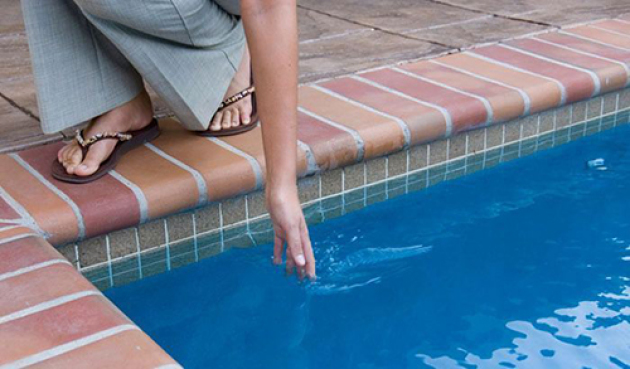


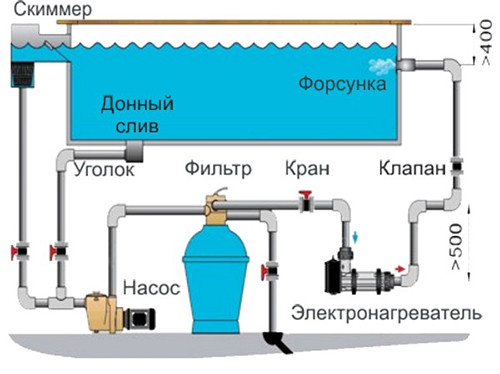
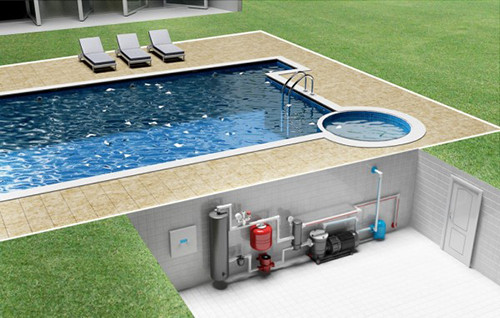
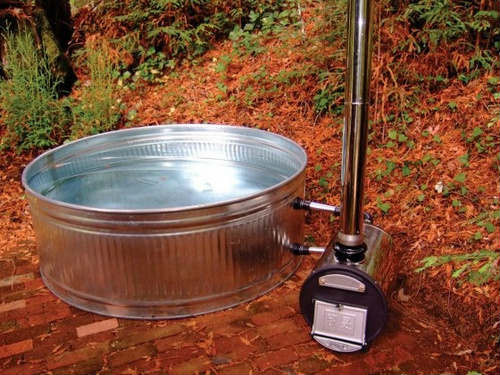

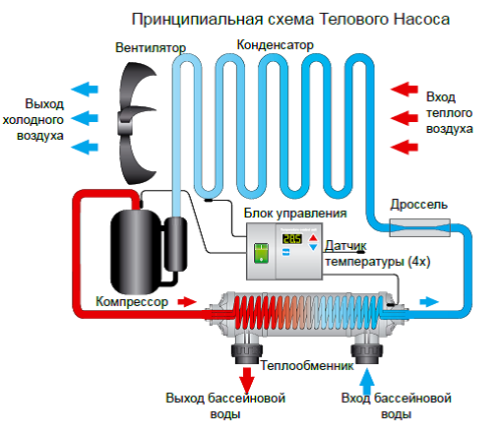
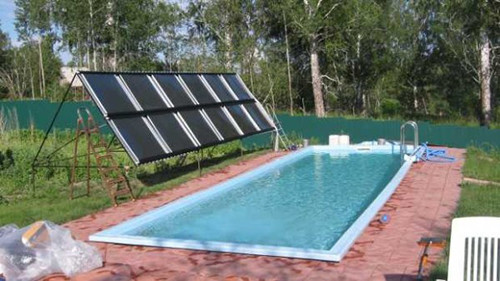
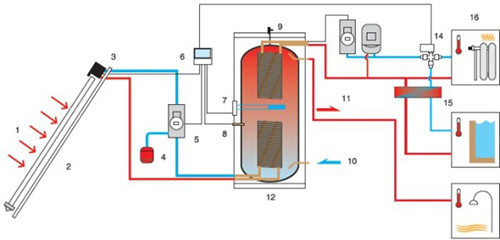
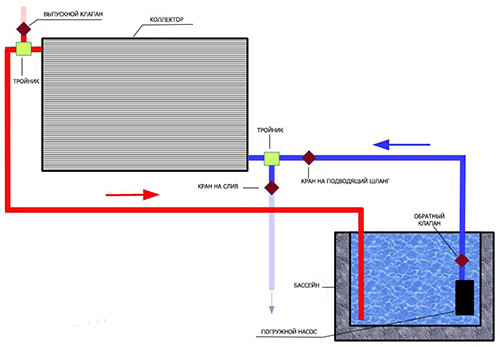
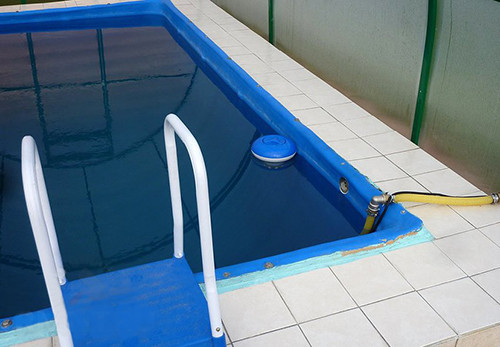
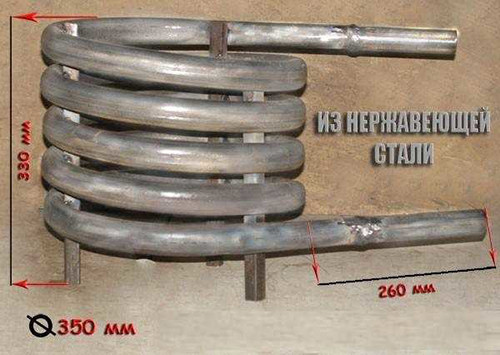

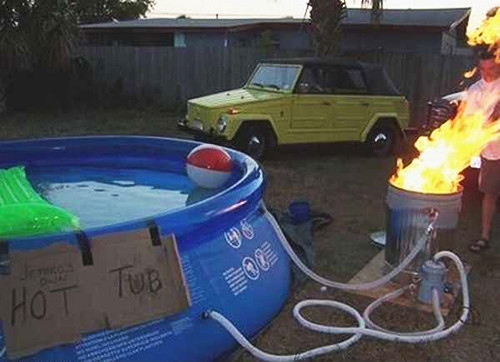
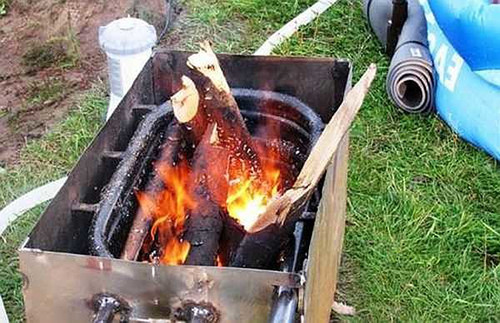
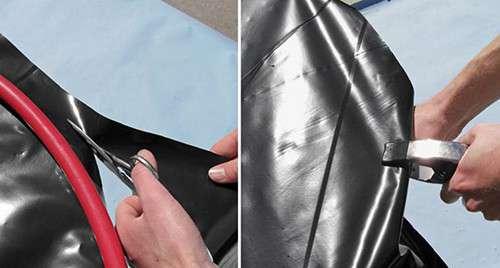
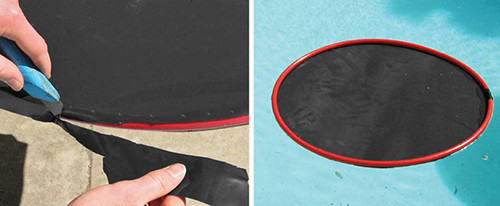

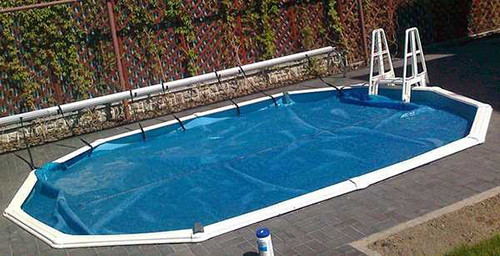












 Start a discussion ...
Start a discussion ...